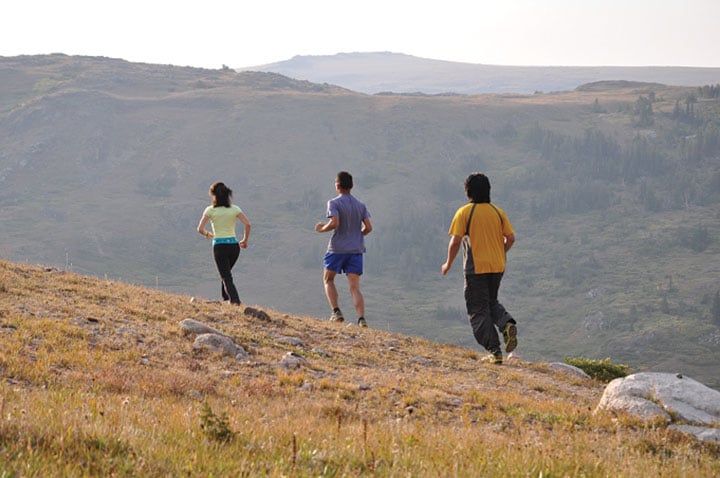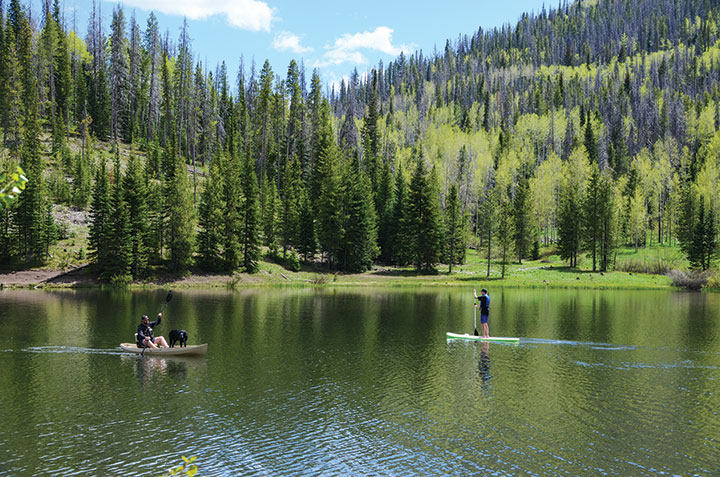RV travel provides countless options for outdoor activities, so long as the weather complies, but for most RVers it also represents a notable deviation from their normal fitness routines. Although some RV resorts offer workout facilities, a public or private campground in the hinterlands of Wyoming or along a lake in Indiana probably isn’t just around the corner from a gym. The narrow, primitive roads leading to some of the nation’s most alluring camping spots are a very different environment for runners or cyclists accustomed to smooth roadways and familiar streets.
For RVers looking to maintain a healthy weight and muscle strength, or even to train for an athletic competition, a camping trip offers numerous possibilities to those willing to adapt and improvise. It’s also a superb opportunity to take a break from established workout routines that sometimes plague participants with boredom and burnout.

Trail running is one of the author’s favorite “get away from it all” fitness activities. It engages muscles in the lower leg for stability and frequently leads to gorgeous scenery. Photos by Jack and Lisa Ballard
Start With a Plan
For most folks, a critical element to achieving weight or fitness goals is devising a plan and maintaining a workout schedule. This is even more important for on-the-go fitness when the ordinary schedule and routines fly out the proverbial window of the RV.

With a plan and a simple kit of portable equipment, a great workout in a setting unlike any gym is part of the RVing experience. Single leg squats target the quads and engage muscles in the lower leg and core for balance.
The first part of planning involves assessing what’s available. Using just body weight and a simple kit of resistance tubes and bands (we’ll get into specifics later), you can get a good workout anywhere. However, the outdoor environment holds other pleasant possibilities for a break from normal routines.
Walkers and runners should check out the availability of nature and hiking trails in the campground and the surrounding area. Although it’s difficult to run at the same pace on irregular trails as when pounding the pavement back home, I love trail running. The natural surface engages small muscles in the ankle area for stability and promotes balance.
Mountain-biking routes offer a similar diversion for those accustomed to logging miles on a road bike. Other possibilities at waterfront destinations include swimming and paddle-sports such as canoeing, kayaking and piloting a stand-up paddleboard.
Another aspect of planning is thinking about the intensity and duration of fitness activities during the outing. The world’s most elite athletes incorporate bouts of “resting” into their routines. These often involve “easy” days and weeks when the intensity and frequency of exercise is temporarily dialed back to give the body time for recovery from stress. When possible, planning a lower-key fitness schedule around a camping trip is a great way to enjoy divergent activities without fretting about the disruption from a focused fitness calendar.
And finally, think about potential safety aspects when planning, and consult your doctor if you have questions about engaging in any of the activities outlined in this article. Exposure to direct sunshine and high temperatures can cause heatstroke and other conditions such as dehydration and sunburn for those accustomed to exercising indoors.
Lowland travelers aiming toward destinations in the mountains should consider the risk of altitude sickness and the increased demands on the body exertion creates at higher elevations. And hikers, runners and mountain bikers in bear country should educate themselves on the best practices to avoid injurious encounters with local bruins (make plenty of noise and carry bear pepper spray).
Core Is King
One of the easiest aspects of physical fitness to incorporate into an outdoor outing is core conditioning. When I was a high school student, conditioning for sports emphasized leg strength and endurance, along with muscle mass and power in the upper body. A couple of sets of obligatory sit-ups were thrown in for good measure, but core conditioning took the second seat to training the upper and lower extremities for competition.
The focus has changed dramatically in the past couple of decades. Strength in the midsection of the body, or “core,” is now acknowledged as supremely important for overall fitness and athletic ability. Muscles in the lower back and abdominal areas stabilize the body and support breathing in every type of athletic competition. Keeping them toned is a cornerstone for general health and avoiding things like backaches during long drives.
For RVers, the good news on core conditioning is its simplicity. An adequate core workout can be had with nothing more than one’s body weight and a flat surface (although most folks will want a padded mat as well). It doesn’t take long to feel the burn when doing crunches, planks and flutter kicks (also works your legs). Should the weather turn nasty, most family-size RVs offer enough floor space for a low-impact core workout.
There’s no limit to the type and variations of core exercises. An online search for ideas yields more suggestions in an hour than one could reasonably incorporate into workouts in an entire year. No matter what specific exercises are used, a balanced core workout hits three areas of the trunk: the frontal abdominal muscles, the lower back and the oft-overlooked oblique muscles on the sides of the abdomen.
Band Aids
With an active travel schedule that keeps us away from home as often as not, my wife, Lisa (a former pro ski racer and member of the U.S. Ski Team), and I utilize our home gym more often than the health club. It includes an exercise bike, a treadmill, some basic free weights and resistance bands and tubing. Lots of resistance bands and tubing. I started using the stuff around 10 years ago as a portable means of maintaining upper- and lower-body strength while on the road. It’s since become a home-gym staple and even more attractive when tucked away at a shady campsite.

Paddlesports target the upper body and core, with SUPs offering a balance component as well. Photo taken at Pearl Lake, Colorado.
Pretty much any strength-building exercise done with free weights or machines can be adapted to resistance bands or tubing. Replicating the load of very heavy weights will be a challenge, but it’s worth noting that research has shown increased repetitions with lighter weight produces similar strength gains with less skeletal and joint stress. For the duration of a camping trip, 20 repetitions of a movement with resistance material versus 10 in the weight room should sufficiently maintain strength.
Resistance tubing consists of stretchy tubes of various diameters. Thicker tubing from the same manufacturer increases the resistance. For some exercises, using multiple tubes will be necessary to achieve the desired results. Resistance bands are made up of similar material but are flat and typically about 4 to 6 inches wide. They’re often ideal for targeting smaller muscle groups. Some bands are formed in a loop that can be placed around the legs or arms. Others are simply a length of stretchy material that can be used in a variety of ways.
To obtain the maximum benefit from resistance bands and tubing, it’s worth a visit to a certified trainer to develop a specific routine. Remember, tubing or bands that show sign of excessive wear or laceration should be discarded to avoid dangerous breakage under load.
Bolster Balance, Find Flexibility
As people age, balance and flexibility tend to suffer. Poor balance is associated with bone-breaking falls in the elderly and tightening muscles that contribute to other injuries. The good news? With a focused program, both balance and flexibility can be maintained throughout adult life.
Stretching for flexibility is a great addition to a camping workout routine. Again, consulting with a professional trainer for advice ahead of time is well worth the investment.

For an even more focused balance session, put up a slackline low to the ground between two anchors such as trees.
Balance can be developed through specific activities or incorporated into other exercises. For example, performing one-legged squats injects a balance component into a strength-building activity. Portable balance apparatuses can also be used.
Lisa and I have great fun on a slack-line. A slackline is basically a length of strong, flat webbing that’s tensioned between two anchoring posts or trees. Walking a slackline takes considerable practice and persistence for the average person but is an ideal way to better your balance.
An RV outing, whether for a week or a weekend, doesn’t have to be a setback for personal fitness. With a little planning and improvisation, it can be a motivating, healthy diversion from the regular regime at home.
 Jack Ballard, Trailer Life contributor and an award-winning author and photographer, has written hundreds of articles on outdoor recreation topics that have been published in more than 50 different magazine titles. He has also written 13 books. Jack’s first RV was a 1961 Aristocrat camping trailer he bought for $500 in 1989. Although he appreciates the technological advances of modern RVs, he retains a keen interest in vintage units.
Jack Ballard, Trailer Life contributor and an award-winning author and photographer, has written hundreds of articles on outdoor recreation topics that have been published in more than 50 different magazine titles. He has also written 13 books. Jack’s first RV was a 1961 Aristocrat camping trailer he bought for $500 in 1989. Although he appreciates the technological advances of modern RVs, he retains a keen interest in vintage units.




